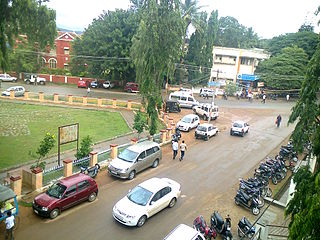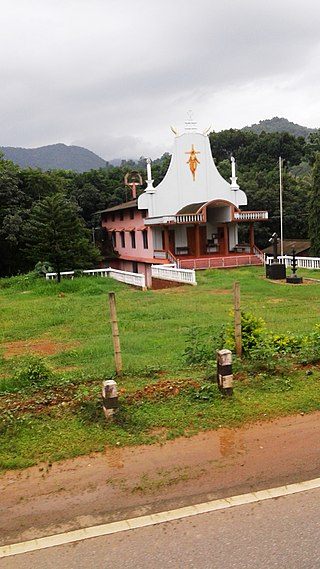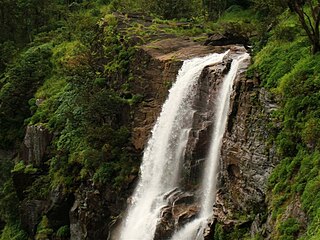
Mangalore, officially known as Mangaluru, is a major industrial port city in the Indian state of Karnataka and on the west coast of India. It is located between the Laccadive Sea and the Western Ghats about 352 km (219 mi) west of Bangalore, the state capital, 14 km north of Karnataka–Kerala border and 297 km south of Goa. Mangalore is the state's only city to have all four modes of transport—air, road, rail and sea. The population of the urban agglomeration was 619,664 according to the 2011 national census of India. It is known for being one of the locations of the Indian strategic petroleum reserves.

Dakshina Kannada district is located in the state of Karnataka in India, with its headquarters in the coastal city of Mangalore. It is part of the larger Tulu Nadu region. The district covers an area nestled in between the Western Ghats to its east and the Arabian Sea to its west. Dakshina Kannada receives abundant rainfall during the Indian monsoon. It is bordered by Udupi district to the north, Chikmagalur district to the northeast, Hassan district to the east, Kodagu to the southeast and Kasaragod district of Kerala to the south. According to the 2011 census of India, Dakshina Kannada district had a population of 2,083,625. It is the only district in Karnataka state to have all modes of transport like road, rail, water and air due to the presence of a major hub, Mangalore. This financial district is also known as the Cradle of Indian banking.

Chikmagalur, officially Chikkamagaluru is an administrative district in the Malnad subregion of Karnataka, India. Coffee was first cultivated in India in Chikmagalur. The hills of Chikmagalur are parts of the Western Ghats and the source of Tunga and Bhadra rivers. Mullayanagiri, the highest peak in Karnataka is located in the district. The area is well known for the Sringeri Mutt that houses the Dakshina Peeta established by Adi Shankaracharya.
Thodikana is an Indian village nestled in the foothills of the Western Ghats in southern Karnataka. It is in the Sullia taluk of Dakshina Kannada district, about 100 km from Mangalore city. This village has much greenery and attracts visitors with its cultural and natural sites.

Chikmagalur is a city and the headquarters of Chikmagalur district in the Indian state of Karnataka. Located on the foothills of the Mullayanagiri peak of the Western Ghats, the city attracts tourists from around the world for its pleasant and favourable hill station climate, tropical rainforest and coffee estates. The pristine Baba Budangiri lies to the north of Chikmagalur where it's believed Baba Budan first introduced coffee to India.

The Beary are a community concentrated along the southwest coast of India, mostly in the Mangalore district of the south Indian state of Karnataka.

Mudigere is a Town Panchayath and Taluk in Chikmagalur district in the Indian state of Karnataka. It is 30 km from the district headquarters.

Sakleshpur, also known as Sakleshpura or Sakleshapura, is a hill station town and headquarters of Sakleshpur taluk and one of the two Sub-divisional headquarters in Hassan district in the Indian state of Karnataka.
Kaikamba also known as Gurupura Kaikamba is a suburban town of Mangalore, Dakshina Kannada District, Karnataka State, west coast of India. Kaikamba lies between Moodabidri and Mangalore city in Dakshina Kannada district. This town lies on Mangalore – Moodabidri Highway National Highway 169. It is 8 km away from Bajpe, where Mangalore International Airport is located. Population of Kaikamba is about 15,325 as per 2009 census. Parts of Kaikamba are administered by Kandavara Panchayat and Ganjimutt Panchayat. Efforts are being made to include this town into Mangalore city corporation limits by the year 2015. The proposed KIADB Software export promotional park is 5 km away.

Ujire is a town near Dharmasthala. It is in Belthangady taluk of Dakshina Kannada district. Ujire is an important junction for travelers in this region. The road at Ujire deviates to Dharmasthala, Kottigehara and Belthangady.
Kadaba is a taluk in Dakshina Kannada district of Karnataka, India. It is located 82 km towards East from District headquarters Mangalore, 31 km from Puttur, 38 km from Sullia and 272 km from State capital Bangalore.

Charmadi Ghat (Charmady) is a ghatti beginning from Belthangady taluk of Dakshina Kannada and ending in Mudigere taluk of Chikmagalur. It is one of the points in Western ghats through which motorable road passes connecting Dakshina Kannada with Chikmagalur district. The section of ghat is known by the name of Charmadi Ghat. It lies on National Highway 73 which connects Mangalore to Tumkur. The nearest places are Charmadi village, Ujire, Belthangady, Puttur, Kottigehara, Balur and Kalasa and Banakal.

Kottigehara is a village located atop the Charmadi ghat in Mudigere taluk of Chikkamagaluru district of Karnataka state, India. It is located 16 km from Mudigere town.The nearest railway stations are at Chikkamagaluru (47 km), Hassan (87 km) and Mangaluru (104 km) respectively. The nearest international airport is Mangalore International Airport. Kottigehara is located at an elevation of 962 m (3,156 ft) above Mean Sea Level.
Manchi is a village in the southern state of Karnataka, India. The village has most of the lands under agriculture. Over 90% of people are literate. The nearest town is B.C Road which is 12 km from Manchi. In Manchi there is a primary school established in 1950 and a high school. Roads connect B.C Road, Vitla, Mangalore and Kalladka. It is located in the Bantwal taluk of Dakshina Kannada district in Karnataka. The office of the gram panchayath is in Kukkaje.

Sampaje is a district border village of Kodagu in the southern state of Karnataka, India. It is located in the Madikeri taluk. It lies on National Highway - 275 which connects Mangalore city in Dakshina Kannada district with Madikeri, Mysuru and Bengaluru.

Bandaje falls, also known as Bandaje Arbi falls is a waterfall located in the Kudremukha section of the Western Ghats in the Belthangady taluk of Dakshina Kannada district, Karnataka. The waterfalls can be reached only by undertaking trekking in thick forests and grass lands with the help of local guides and in summer the waterfalls goes dry. The height of waterfalls is about 200 feet.
Patrame is a small, rural panchayat village on the left (east) bank of the Netravati River in Karnataka, India. Administratively, it is under Belthangady taluk, Dakshina Kannada district, Karnataka. Patrame is the only village in its gram panchayat. The village of Patrame is 26 km from its taluk headquarters Belthangady, and 8 km by road from Dharmasthala.
Tulu Gowda and Arebhashe Gowda (Gauda) are primarily found in South Canara District, Kodagu District, Indian state of Karnataka and Bandadka village of Kasaragod. They are a subsect of the Vokkaliga community but are culturally and linguistically different. They speak Tulu and Arebhashe.
Panathur – Karike belt is on the border of Kasargod district of Kerala & Coorg and Dakshina Kannada districts in the Indian state of Karnataka. It is 44 km east of Kanhangad, 30 km from Bhagamandala in Kodagu and 22 km from Sullia in Dakshina Kannada. Kerala and Karnataka are separated by the Manjanadukkam Puzha River. In Panathur, people speak Malayalam and in Karike Kannada. Marathi, Tulu, Konkani and Harijan Bashe are also spoken here. The area produces rubber, areconut, coconut, pepper and other agricultural products. The land is surrounded by Coorg forests and Kerala Plantation Corporation which runs over 2,200 hectares.
Shishila is a village located at the base of Western Ghats in Belthangady taluk of the Karnataka State, India. The main attraction of the village is a temple dedicated to Lord Shishileshwara.














